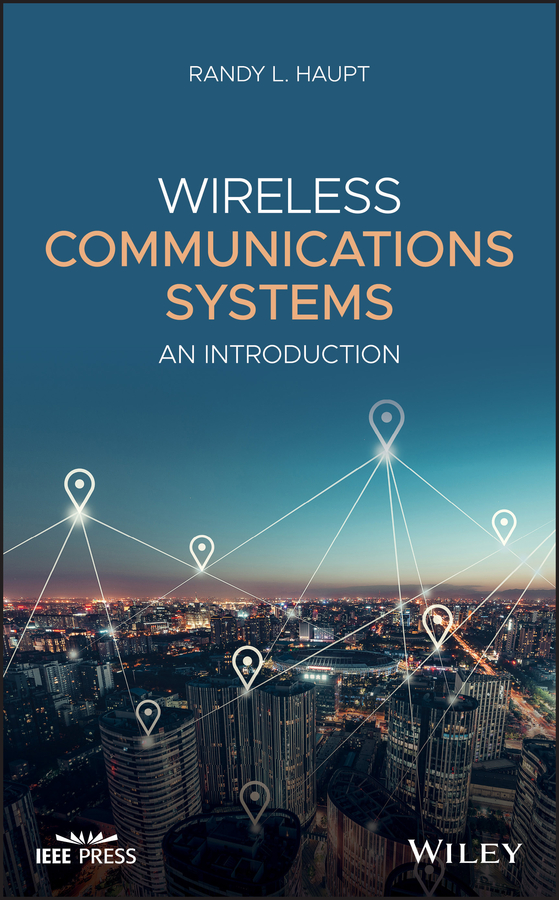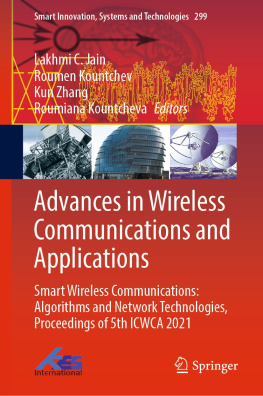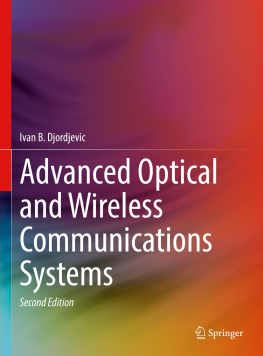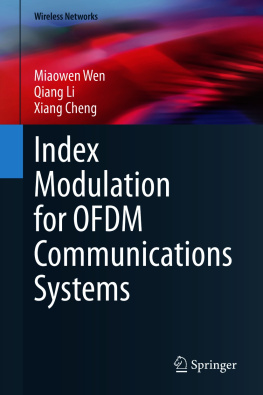
Table of Contents
List of Tables
- Chapter 1
- Chapter 2
- Chapter 3
- Chapter 4
- Chapter 5
- Chapter 6
- Chapter 7
- Chapter 8
- Chapter 10
- Chapter 11
- Chapter 12
- Appendix C
- Appendix E
List of Illustrations
- Chapter 1
- Chapter 2
- Chapter 3
- Chapter 4
- Chapter 5
- Chapter 6
- Chapter 7
- Chapter 8
- Chapter 9
- Chapter 10
- Chapter 11
- Chapter 12
- Appendix B
- Appendix D
- Appendix F
Guide
Pages
Wireless Communications Systems
An Introduction
Randy L. Haupt
Colorado School of Mines
Department of Electrical Engineering
This edition first published 2020
2020 John Wiley & Sons, Inc.
Edition History
All rights reserved. No part of this publication may be reproduced, stored in a retrieval system, or transmitted, in any form or by any means, electronic, mechanical, photocopying, recording or otherwise, except as permitted by law. Advice on how to obtain permission to reuse material from this title is available at http://www.wiley.com/go/permissions.
The right of Randy L Haupt to be identified as the author of this work has been asserted in accordance with law.
Registered Office
John Wiley & Sons, Inc., 111 River Street, Hoboken, NJ 07030, USA
Editorial Office
111 River Street, Hoboken, NJ 07030, USA
For details of our global editorial offices, customer services, and more information about Wiley products visit us at www.wiley.com.
Wiley also publishes its books in a variety of electronic formats and by printondemand. Some content that appears in standard print versions of this book may not be available in other formats.
Limit of Liability/Disclaimer of Warranty
While the publisher and authors have used their best efforts in preparing this work, they make no representations or warranties with respect to the accuracy or completeness of the contents of this work and specifically disclaim all warranties, including without limitation any implied warranties of merchantability or fitness for a particular purpose. No warranty may be created or extended by sales representatives, written sales materials or promotional statements for this work. The fact that an organization, website, or product is referred to in this work as a citation and/or potential source of further information does not mean that the publisher and authors endorse the information or services the organization, website, or product may provide or recommendations it may make. This work is sold with the understanding that the publisher is not engaged in rendering professional services. The advice and strategies contained herein may not be suitable for your situation. You should consult with a specialist where appropriate. Further, readers should be aware that websites listed in this work may have changed or disappeared between when this work was written and when it is read. Neither the publisher nor authors shall be liable for any loss of profit or any other commercial damages, including but not limited to special, incidental, consequential, or other damages.
Library of Congress CataloginginPublication Data is applied for
9781119419174
Cover Design: Wiley
Cover Image: Dong Wenjie/Getty Images
To the wonderful girls in my life: Sue Ellen, Bonny, Amy, Adeline, and Rose. You give me love and inspiration
Preface
This book targets undergraduate and graduate students as well as professionals wanting an introduction to wireless communication systems. Wireless systems pervade all aspects of our lives. I have been an insulindependent diabetic most of my life. Recently, I got a continuous blood glucose monitor (). This monitor dramatically changed my life for the better due to the technologies presented in this book. Even though wireless systems have exponentially expanded over my lifetime, the future looks even brighter. Learning about wireless systems leads to a significant advantage over the uninformed.
My career in wireless systems covers a wide range of different projects in industry, government, and academia. I have taught courses in wireless communications, analog and digital communications, digital signal processing, probability and statistics, antennas, electromagnetics, softwaredefined radios, electronics, electromagnetic compatibility, optimization, and radar at six different universities and also presented many special topic short courses. I thought that my diverse background would prepare me for writing a book on wireless systems. Writing this book humbled me, however. Universities usually have one or more courses based on each chapter in this book. I learned a lot in the writing process, and I tried to convey very complex information as clear and simple manner as possible with plenty of pictures and examples.
This book has two parts: fundamentals (). The appendices provide some supplemental information for the reader. I relied on MATLAB for most of the computations and graphics. There are plenty of examples and pictures illustrating many different aspects of wireless technology in our lives. Even though I tried to simplify the concepts, students still need some knowledge in electromagnetics, math through calculus, probability, and linear systems.
The first half of this book delves into theory with many examples of practical applications. concerns many aspects of RF propagation from HF to mm waves.
I selected seven examples of wireless applications for the second half of the book. These examples make use of the theory introduced in the first half of the book.. Security and health effects of wireless systems concern users and designers.
I teach the first five chapters of the book and some of the systems described in the remaining chapters in my class. I like to have the students do plenty of MATLAB programming and use hardware experiments to enhance the theory. My students do final projects and make presentations in lieu of a final exam. I have students purchase RTL softwaredefined radios () to have some hardware to test the theory they learn. My goal is to prepare them for a job in the wireless technology sector. This goal makes this book unique.
I have extra material available for instructors who adopt this text in the form of PowerPoint slides, videos, and additional problems. Please contact the publisher to arrange for access.
I owe many thanks to the people who spent time reviewing portions of this book: Sue Haupt, Payam Nayeri, Bonny Turayev, Amy Shockley, Jake Shockley, and Mark Leifer. They pushed me to do better.
Randy L. Haupt
Boulder, CO
Symbols and Acronyms
Symbols
Alow sidelobe taper factorAarray steering matrix
Ae effective aperture
ALOS amplitude of the LOS signal
Am amplitude of the message signalAFarray factor AFN array factor normalized to
N AFx
xaxis array factor AFy
yaxis array factorAPantenna patternApindex of geomagnetic activity
Ap physical apertureARaxial rationaone dimension of rectangular slot
an weightsBbandwidthbone dimension of rectangular slot
bn bit
nbn weights
bpn parity bit
nBERbit error rateCchannel capacityCcovariance matrix
Next page










